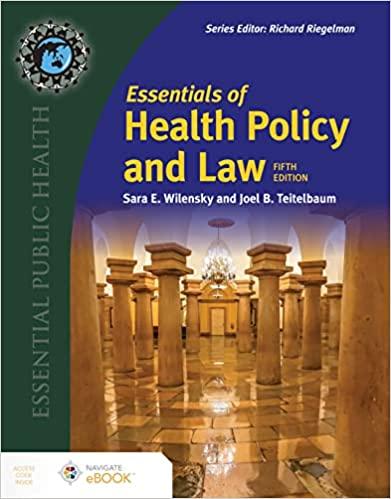Both AHPs and STLDs are likely to limit benefits, be priced on the basis of an individuals
Question:
Both AHPs and STLDs are likely to “limit benefits, be priced on the basis of an individual’s health status, and impose lifetime and annual spending limits, and insurers could reject applicants on the basis of their health and any preexisting condition” (CBO, 2018, p. 10). One review of short-term plans found that 71% did not cover outpatient prescription drugs, 62% did not cover substance abuse services, 43% did not cover mental health services, and no plans covered maternity care (Pollitz et al., 2018). Concerns about STLD plans have led 12 states to prohibit insurers from using health status as a factor in medical underwriting, effectively eliminating those plans. Another 13 states and the District of Columbia limit plan duration to the original 3-month time frame (National Association of Insurance Commissioners [NAIC], 2020). CBO and the Joint Committee on Taxation (JCT) estimate that approximately 5 million people will enroll in AHPs or short-term plans each year from 2019 to 2028 (CBO, 2019b). Of those 5 million individuals, approximately 75% will enroll in an AHP and 80% will have been previously insured (CBO, 2019b).
When insurers are allowed to offer nongroup plans that do not have to comply with the ACA provisions, it becomes possible to create cheaper and skimpier insurance products. As a result, adverse selection is likely to occur in the exchange plans as healthier individuals who do not believe they need a comprehensive plan—or do not want to pay a higher premium to participate in one—leave the exchange plan and move to a cheaper nongroup option. Furthermore, the repeal of the individual mandate penalty makes it likely that some healthier individuals will choose a cheaper, less comprehensive option, leaving the ACA-compliant plans with a sicker and more expensive pool of enrollees. An analysis of insurers that detailed the policy and legislative reasons for requesting rate changes found that in 2019, premiums would “be an average of 6% higher, as a direct result of individual mandate repeal and expansion of more loosely regulated plans, than would otherwise be the case” (Kamal et al., 2018). In addition, states without STLD plan limits are expected to experience a 4% increase in ACA premiums and a 6% decrease in enrollment in ACA-compliant plans (NAIC, 2020).
Step by Step Answer:

Essentials Of Health Policy And Law
ISBN: 9781284247459
5th Edition
Authors: Sara E. Wilensky, Joel B. Teitelbaum





